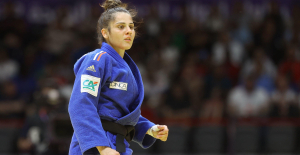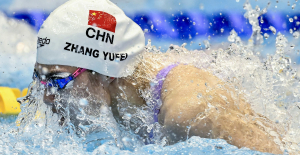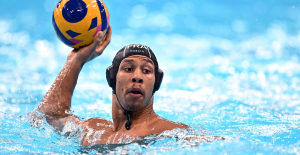Skateboarding is not a Japanese culinary delight, but a rich source of delicious morsels. Sunday's competition in the new Olympic sport of skateboarding will be conducted in a completely different language.
Skaters use a jargon to describe their tricks. This allows them to communicate with each other regardless of where they are from. For example, an ollie is a ollie from Paris, Portland, or Perth.
Alexis Sablone, a U.S. skater, says that "you can meet friends skating really fast because of this." "Even though you don't know all the tricks, you can still cheer each other on and skate together.
Skate-speak is also time-saving. It is much easier to say "ollie" rather than "skating’s basic trick, where the skater makes the board take flight by pushing down on its tail, and then, once it has landed, levels it out before landing."
A nollie? The same trick but with the nose acting as the take-off impulsion. Nose. Nollie. Get it? Many of the lingo has a logic. Olympic fans will soon be able to speak skating in no time.
THE ABCs: Skaters will race over steps, rails, ledges, and other urban furniture in the "street" competition. On Sunday, the men will go, while Sablone and the women will follow on Monday.
The 20 contestants will then be judged on their style and skills over two runs of 45 seconds each and five individual tricks. The final eight finalists will be chosen. In week two of the "park" competition, skaters will be able to roll around in a huge, feature-filled bowl.
Sablone is one example of this. He skates "goofy" with his right foot forward as opposed to "regular" skaters who skate with their left foot forward. They can also "switch," which is riding against their natural preferences. They'll need to do stunts that are both dangerous and exciting.
TALKING THE TALL: Sometimes the names of tricks can tell their story. Scraping one or both of the "trucks", the strong axles at the bottom of the board, along with a curb, rail or other obstacle is a "grind," which evokes the sound of metal against metal or concrete.
It's called a "slide" if the surface that is scraping the wood board is the one between the wheels ("boardslide") and the tail ("tailslide")).
Some tricks with degrees of rotation are also easy to identify. The "frontside 180" ollie has skater and board turning half-turns while being airborne. Or the "frontside 360" ollie, where the skater and board do a complete rotation.
There are many ways to grab the skateboard, such as holding onto it with one hand or clutching it in mid-air. The stalefish is one, held between the heels.
There are so many variations.
What's in a Name?
Some tricks pay tribute to their creators. Steve Caballero is the name of the 360-rotated "caballerial," which is ridden backwards. Eric Dressen's surname, which sounds similar to salad dressings, is the reason that the salad grind was named after him. This play on words was the inspiration for the name.
Greg Poissonnier says that there are no rules when it comes to naming tricks. He'll be commenting about Olympic skateboarding on French TV. He also contributed to an illustrated guide or "tricktionary" of skating stunts.
He says, "Sometimes it's just the name they gave it at that moment." "They are like, We've done that, now what's the name?' and they give it a name."

 Hamas-Israel war: US begins construction of pier in Gaza
Hamas-Israel war: US begins construction of pier in Gaza Israel prepares to attack Rafah
Israel prepares to attack Rafah Indifference in European capitals, after Emmanuel Macron's speech at the Sorbonne
Indifference in European capitals, after Emmanuel Macron's speech at the Sorbonne Spain: what is Manos Limpias, the pseudo-union which denounced the wife of Pedro Sánchez?
Spain: what is Manos Limpias, the pseudo-union which denounced the wife of Pedro Sánchez? Spain is the country in the European Union with the most overqualified workers for their jobs
Spain is the country in the European Union with the most overqualified workers for their jobs Parvovirus alert, the “fifth disease” of children which has already caused the death of five babies in 2024
Parvovirus alert, the “fifth disease” of children which has already caused the death of five babies in 2024 Colorectal cancer: what to watch out for in those under 50
Colorectal cancer: what to watch out for in those under 50 H5N1 virus: traces detected in pasteurized milk in the United States
H5N1 virus: traces detected in pasteurized milk in the United States Private clinics announce a strike with “total suspension” of their activities, including emergencies, from June 3 to 5
Private clinics announce a strike with “total suspension” of their activities, including emergencies, from June 3 to 5 The Lagardère group wants to accentuate “synergies” with Vivendi, its new owner
The Lagardère group wants to accentuate “synergies” with Vivendi, its new owner The iconic tennis video game “Top Spin” returns after 13 years of absence
The iconic tennis video game “Top Spin” returns after 13 years of absence Three Stellantis automobile factories shut down due to supplier strike
Three Stellantis automobile factories shut down due to supplier strike A pre-Roman necropolis discovered in Italy during archaeological excavations
A pre-Roman necropolis discovered in Italy during archaeological excavations Searches in Guadeloupe for an investigation into the memorial dedicated to the history of slavery
Searches in Guadeloupe for an investigation into the memorial dedicated to the history of slavery Aya Nakamura in Olympic form a few hours before the Flames ceremony
Aya Nakamura in Olympic form a few hours before the Flames ceremony Psychiatrist Raphaël Gaillard elected to the French Academy
Psychiatrist Raphaël Gaillard elected to the French Academy Skoda Kodiaq 2024: a 'beast' plug-in hybrid SUV
Skoda Kodiaq 2024: a 'beast' plug-in hybrid SUV Tesla launches a new Model Y with 600 km of autonomy at a "more accessible price"
Tesla launches a new Model Y with 600 km of autonomy at a "more accessible price" The 10 best-selling cars in March 2024 in Spain: sales fall due to Easter
The 10 best-selling cars in March 2024 in Spain: sales fall due to Easter A private jet company buys more than 100 flying cars
A private jet company buys more than 100 flying cars This is how housing prices have changed in Spain in the last decade
This is how housing prices have changed in Spain in the last decade The home mortgage firm drops 10% in January and interest soars to 3.46%
The home mortgage firm drops 10% in January and interest soars to 3.46% The jewel of the Rocío de Nagüeles urbanization: a dream villa in Marbella
The jewel of the Rocío de Nagüeles urbanization: a dream villa in Marbella Rental prices grow by 7.3% in February: where does it go up and where does it go down?
Rental prices grow by 7.3% in February: where does it go up and where does it go down? “Deadly Europe”, “economic decline”, immigration… What to remember from Emmanuel Macron’s speech at the Sorbonne
“Deadly Europe”, “economic decline”, immigration… What to remember from Emmanuel Macron’s speech at the Sorbonne Sale of Biogaran: The Republicans write to Emmanuel Macron
Sale of Biogaran: The Republicans write to Emmanuel Macron Europeans: “All those who claim that we don’t need Europe are liars”, criticizes Bayrou
Europeans: “All those who claim that we don’t need Europe are liars”, criticizes Bayrou With the promise of a “real burst of authority”, Gabriel Attal provokes the ire of the opposition
With the promise of a “real burst of authority”, Gabriel Attal provokes the ire of the opposition These French cities that will boycott the World Cup in Qatar
These French cities that will boycott the World Cup in Qatar Judo: Blandine Pont European vice-champion
Judo: Blandine Pont European vice-champion Swimming: World Anti-Doping Agency appoints independent prosecutor in Chinese doping case
Swimming: World Anti-Doping Agency appoints independent prosecutor in Chinese doping case Water polo: everything you need to know about this sport
Water polo: everything you need to know about this sport Judo: Cédric Revol on the 3rd step of the European podium
Judo: Cédric Revol on the 3rd step of the European podium


















